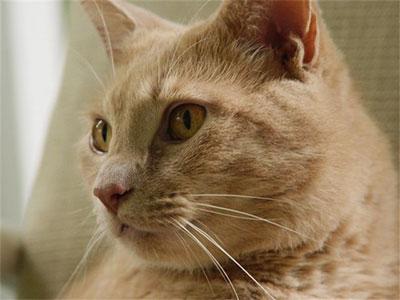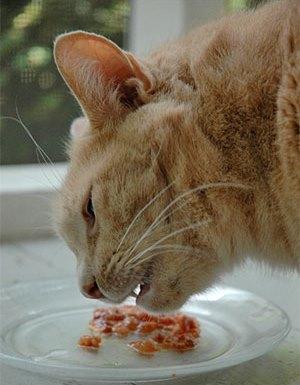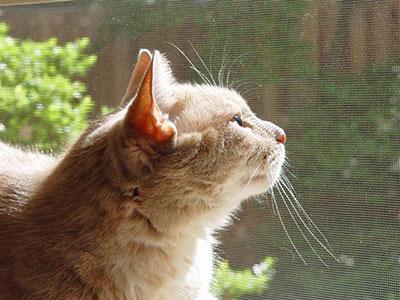This content is archived from the Feline Nutrition Foundation
Duke's Story: Inflammatory Bowel Disease
- Updated: Thursday, April 02, 2020 12:08 PM
- Published: Sunday, May 17, 2009 11:25 AM
- Written by Anne Jablonski
 Just about eight years ago, I had a mighty sick cat on my hands. My gentle-tempered orange tabby had been unwell since he was a kitten. Six years into his life, I was thoroughly exasperated and struggling to understand why it was that this well-cared for, amply loved creature had relentless diarrhea and low energy. I'd lived with and loved cats before, and I had what I thought was a pretty impressive library of cat care books. I did everything my vet suggested, forking over whatever I had to for quality "prescription formula" food and waiting impatiently for him to improve. My vet seemed to be trying very hard, but described it like this: the ailment that my furry orange friend suffered from – inflammatory bowel disease – was incurable and, at best, potentially "manageable." Nothing I was doing was "managing" anything. His diarrhea was unremitting and the poor little fellow had observable cramping and discomfort. He was in pain. And I was in pain watching him. It's very discouraging to be doing everything you think you can to solve a problem and getting nowhere. On most days, he was in the same predictable state of low grade chronic misery, but on other days his conspicuously painful flare-ups nearly broke my heart in two.
Just about eight years ago, I had a mighty sick cat on my hands. My gentle-tempered orange tabby had been unwell since he was a kitten. Six years into his life, I was thoroughly exasperated and struggling to understand why it was that this well-cared for, amply loved creature had relentless diarrhea and low energy. I'd lived with and loved cats before, and I had what I thought was a pretty impressive library of cat care books. I did everything my vet suggested, forking over whatever I had to for quality "prescription formula" food and waiting impatiently for him to improve. My vet seemed to be trying very hard, but described it like this: the ailment that my furry orange friend suffered from – inflammatory bowel disease – was incurable and, at best, potentially "manageable." Nothing I was doing was "managing" anything. His diarrhea was unremitting and the poor little fellow had observable cramping and discomfort. He was in pain. And I was in pain watching him. It's very discouraging to be doing everything you think you can to solve a problem and getting nowhere. On most days, he was in the same predictable state of low grade chronic misery, but on other days his conspicuously painful flare-ups nearly broke my heart in two.
Mind you, I'd always had a fairly healthy skepticism about mainstream approaches to health and medical care, but I knew very little about cat nutrition and I presumed that veterinarians, with all those years of study under their belt, would let me know if there was something different I should be doing when it came to feeding him. They were, after all, the experts on disease.
In retrospect, I see now that nutrition was at most a casual afterthought in virtually all of the discussions I had with the scores of veterinary specialists to whom I dragged my furry little fellow month after month, year after year. Their focus was almost invariably on masking symptoms and keeping him as comfortable as possible through acute flare-ups. I followed their advice to feed him "scientifically engineered" prescription kibble, hospitalized and subcutaneously hydrated him when things really went south, and offered canned food offered occasionally as a treat.
Nothing changed until I began to suspend my trust in mainstream approaches to the disease and started engaging a little common sense.
The short version of the story is that his illness – and what at long last cured him of it – evoked a strong passion in me for cat nutrition and gave birth to what would become a surprisingly popular website devoted to that issue. The more I learned, the more I was simultaneously delighted and disappointed to find there was a small but devoted critical mass of lay people and veterinarians out there who had spent years thinking through the issue of feline nutrition. They could see with perfect clarity what it took me years to understand. On the one hand, I was delighted to run across these trailblazers who helped me see what I'd been doing wrong. On the other hand, I was disappointed that no veterinarian that had ever treated my cat had thought or known to suggest the same simple steps I took, with patient mentoring from this small, wise group of feline nutrition pioneers.¹

The story of my marvelous feline beast, Duke, and our journey into the world of raw feeding is detailed extensively on my website, so I'll skip any more details of that here. Simply put, when I finally got it through my thick head that the fuel I was putting into my carnivore's engine was not remotely close to what he required, everything made sense. Once I understood the big picture, all the specifics and details of this and many other cat diseases that had confounded me before suddenly came into sharp focus.
If there's one big takeaway I'd like you to consider, it's this: if you have a cat that's unwell, just for a few moments, set aside your own assumptions about what you think you know – or what you presume your vet must know – about what a cat should eat. Then consider the implications of the one, simple, elegantly instructive fact that cats are true (obligate) carnivores.
If you're living with a cat, you're living with a meat-eater. And if the meat-eater you're living with is sick, ask yourself if the food that is moving through his system can be reconciled with his carnivore-hood.
This really isn't rocket science: Obligate carnivores are built from the ground up to derive their nutrition from eating other animals. Period. They derive almost zero nutritional benefit from the consumption of plant matter. Period. Moreover, ingesting plant matter (grains, vegetables, berries, fruits) not only robs them nutritionally, it can – and very often does – trigger disease.
Consider some of these basic facts about the relationship between very common feline diseases and nutrition:
Inflammatory bowel disease, with its attendant symptoms of diarrhea and vomiting, is the body's rebellion against trying to process foods it was never built to eat. A cat can never be a successful herbivore or omnivore and will never win any battle against digestive illness without consuming the enzyme-rich, meat-based food he or she was biologically engineered to ingest. Cats with IBD are desperate for biologically available nutrition while their increasingly exhausted bodies stay busy violently rejecting the inappropriate food that is moving through their compromised digestive tracts. It's an unhappy combination. But it's entirely fixable.
 Feline diabetes, as has been intelligently and credibly documented by one of the leading veterinarians in the country on that disease, Dr. Elizabeth Hodgkins, is "man-made." It's completely avoidable by staying away from carbohydrate-heavy dry kibble. If we are consistently feeding highly processed meat-flavored cereal to carnivores, it's no surprise that their endocrine systems go haywire.
Feline diabetes, as has been intelligently and credibly documented by one of the leading veterinarians in the country on that disease, Dr. Elizabeth Hodgkins, is "man-made." It's completely avoidable by staying away from carbohydrate-heavy dry kibble. If we are consistently feeding highly processed meat-flavored cereal to carnivores, it's no surprise that their endocrine systems go haywire.
Obesity, another entirely avoidable malady that causes great suffering in cats and makes them more prone to diabetes and fatty liver disease (just for starters), is the direct consequence of feeding a carnivore food that's only fit for herbivores. In the exquisitely efficient digestive system of a carnivore, carbohydrates aren't burned for energy, but turn to fat. Dry food, so heavy in carbohydrates, is the culprit, plain and simple.
Urinary tract disorders are far too common in cats these days, but given the naturally low thirst drive of cats, it's easy to see how dry foods – with their unavoidably low moisture levels (around 10 percent) – create ideal preconditions for a cat's plumbing to break down. We know from veterinary research that a cat eating a predominantly dry diet, even with supplemental water drinking, takes in roughly half the total moisture of a cat eating canned or raw food. And we also know that the healthiest pH balance in a cat's urinary tract comes from eating low-carbohydrate, high-protein food.
These examples are only the tip of the iceberg. Skin disorders and "allergies," kidney malfunction, periodontal disease, cancer and pancreatic disorders all have at least some compelling relationship to diet.
Knowing all this is not a reason to despair. You're free to spend a little time like I did at first, stewing over how wildly wrong so many of us have been all these years trusting that dry food was a perfectly fine choice for cats. But in the end, knowing with certainty what we know now is reason to cheer. We can simply look to Mother Nature, who worked this all out long ago, for answers.
A mouse is the perfect nutrition package for a cat. A mouse has about three percent carbohydrate. Dry cat food has between 35 and 50 percent carbohydrate. It doesn't take a veterinary degree to work out that the widely accepted practice of feeding cats dry food makes them sick and does not create conditions for them to thrive. Conversely, we can see how something as simple as getting the diet right holds the potential to fix what's wrong – and often with breathtaking speed.
Diet is a Very Big Thing to get wrong. But the good news is that it's not at all hard to get right.
 The movement toward and demand for more and better choices in food for our carnivores is growing fast. A few years ago there were only a handful of companies out there selling biologically appropriate and healthy food for cats, but their numbers are growing. I personally know of at least one established pet supply store in my area – a retail icon – that courageously decided in 2008 to stop selling dry food.
The movement toward and demand for more and better choices in food for our carnivores is growing fast. A few years ago there were only a handful of companies out there selling biologically appropriate and healthy food for cats, but their numbers are growing. I personally know of at least one established pet supply store in my area – a retail icon – that courageously decided in 2008 to stop selling dry food.
Meanwhile, veterinary discussion boards are buzzing with spirited debate on the issue of raw feeding, mainstream veterinarians are becoming more prominent and vocal in their clarion call for common sense approaches to feeding cats, and the glaring problems with the ingredients that make up the bulk of foods sold at pet food supply stores and veterinary offices are getting more national and international media attention.
Everything is moving in a very healthy direction, at long last. What good news!
Additional Reading
Saving Alistair: How Lyn Thomson Helped Stop IBD 11,000 Miles Away
When a Vegetarian Feeds A Raw Diet
I am extraordinarily humbled and honored to be even a small part of the magnificent educational and public outreach work of Feline Nutrition. My hat is off to its hardworking founder for turning her own energy and passion on this vital subject into such a worthy and ambitious project that will undoubtedly benefit countless cats and their loving caregivers for years to come.
Finally, I'm tickled to report that the orange tabby hero of my own story here, Duke, turned 15 years old this year. Alongside his sassy adopted sister, he is a strapping, healthy beast who thrives on the home-prepared raw diet and is as proud as I am to be associated with Feline Nutrition.
Anne Jablonski is a pioneering advocate of species appropriate feeding for cats. She founded theCatNutrition.orgwebsite to help other cats and their humans discover the many benefits of a raw diet.
1. The particular pioneers who deserve all the credit for opening my eyes, refining my knowledge of cat nutrition, and keeping me honest include Michelle Bernard, Natascha Wille, Lee Ellis, Dr. Lisa Pierson and Dr. Elizabeth Hodgkins.




